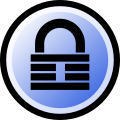 | |
 KeePass 2.x Main Window | |
| Developer(s) | Dominik Reichl |
|---|---|
| Initial release | November 16, 2003 |
| Stable release | 1.42 and 2.57
/ February 1, 2024 (1.42) and June 1, 2024 (2.57) |
| Repository | Sourceforge |
| Written in | C# (2.x version), C++ (1.x version) |
| Operating system | Windows, Linux, MacOS, BSD |
| Platform | .NET Framework, Mono |
| Available in | English |
| Type | Password manager |
| License | GPL-2.0-or-later |
| Website | keepass |
KeePass Password Safe is a free and open-source password manager primarily for Windows. It officially supports macOS and Linux operating systems through the use of Mono.[1] Additionally, there are several unofficial ports for Windows Phone, Android, iOS, and BlackBerry devices, which normally work with the same copied or shared (remote) password database.[2][3][4][5][6] KeePass stores usernames, passwords, and other fields, including free-form notes and file attachments, in an encrypted file. This file can be protected by any combination of a master password, a key file, and the current Windows account details. By default, the KeePass database is stored on a local file system (as opposed to cloud storage).[7]
KeePass comes in two different variants: KeePass 1.x and KeePass 2.x. Although the 1.x variant is the former variant it is supported indefinitely: Dominik Reichl: "2.x isn't the successor of 1.x, and 1.x isn't dead".[8] KeePass 2.x has a different software basis in C# instead of the former C++. Mainly communication features are extended in KeePass 2.x: authentication with the Windows user account, remote and shared database editing as well as many plugins allowing communication and authentication with different web browsers, databases and more.[9][10]
KeePass 1.x and 2.x support a number of plugins, although 2.x allows more plugins.[10] It has a password generator and synchronization function, supports two-factor authentication, and has a Secure Desktop mode. It can use a two-channel auto-type obfuscation feature to offer additional protection against keyloggers.[11] KeePass can import from over 30 other most commonly used password managers.[11]
A 2017 Consumer Reports article described KeePass as one of the four most widely used password managers (alongside 1Password, Dashlane and LastPass), being "popular among tech enthusiasts" and offering the same level of security as non-free competitors.[12]
A 2019 Independent Security Evaluators study described KeePass as well as other widely used password managers as being unable to control Windows 10's tendency to leave passwords in cleartext in RAM after they are displayed using Windows controlled GUI.[13] In addition, several GitHub projects (KeeFarce, KeeThief, Lazanga) specifically attack a running KeePass to steal all data when the host is compromised. KeePass cannot prevent password theft and, as Dominik Reichl, the administrator of KeePass, states, "neither KeePass nor any other password manager can magically run securely in a spyware-infected, insecure environment."[14]
- ^ "Setup". KeePass. Archived from the original on 2023-12-09.
- ^ "Download". KeePass.
- ^ "7Pass" – via Word press.
- ^ "KeePassDroid". Google Play Store. Brian Pellin. Retrieved 24 March 2024.
- ^ "BlackBerry World – KeePass for BlackBerry". Appworld. Blackberry. Archived from the original on 2013-06-22. Retrieved 2014-03-26.
- ^ "iOS application". iTunes. Apple.
- ^ Zukerman, Erez. "Tools for the Paranoid: 5 Free Security Tools to Protect Your Data". PC World. Retrieved 2013-07-14.
- ^ Reichl, Dominik, "Development Status FAQ", KeePass.
- ^ Reichl, Dominik, "Edition Comparison", KeePass.
- ^ a b Reichl, Dominik. "Plugins". Keepass.
- ^ a b Rubenking, Neil. "KeePass Review & Ratings". PC Magazine. Retrieved 2014-06-11.
- ^ Chaikivsky, Andrew (2017-02-17). "Everything You Need to Know About Password Managers". Consumer Reports. Retrieved 2018-06-23.
- ^ Bednarek, Adrian. "Password Managers: Under the Hood of Secrets Management". Security evaluators. Retrieved 2019-03-24.
- ^ Reichl, Dominik. "Security Issues". KeePass. Archived from the original on 2019-09-03. Retrieved 2019-03-24.